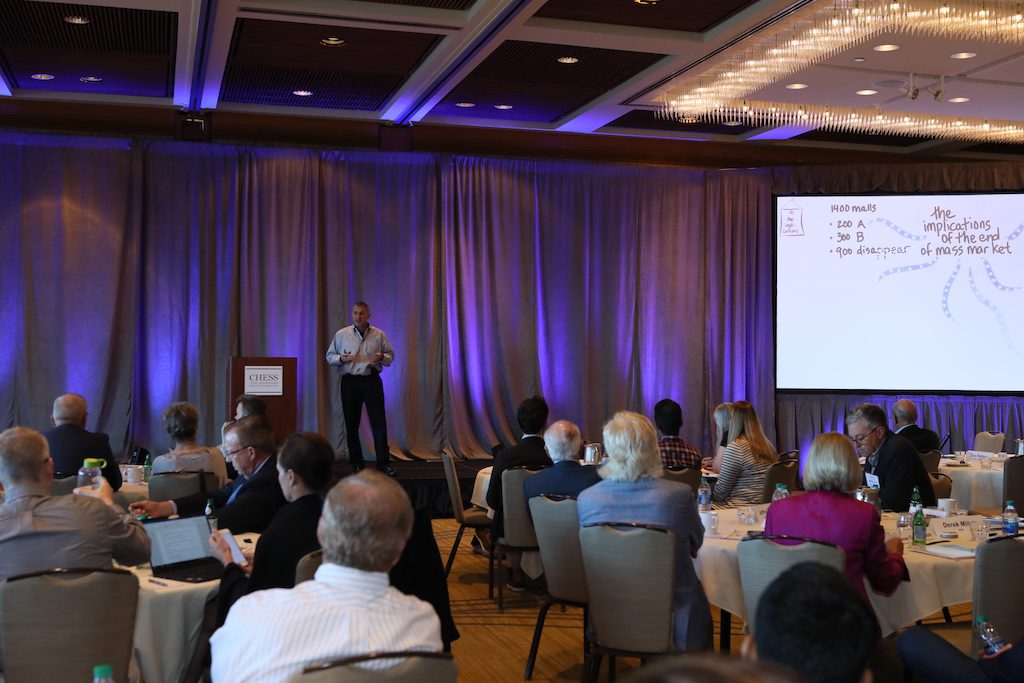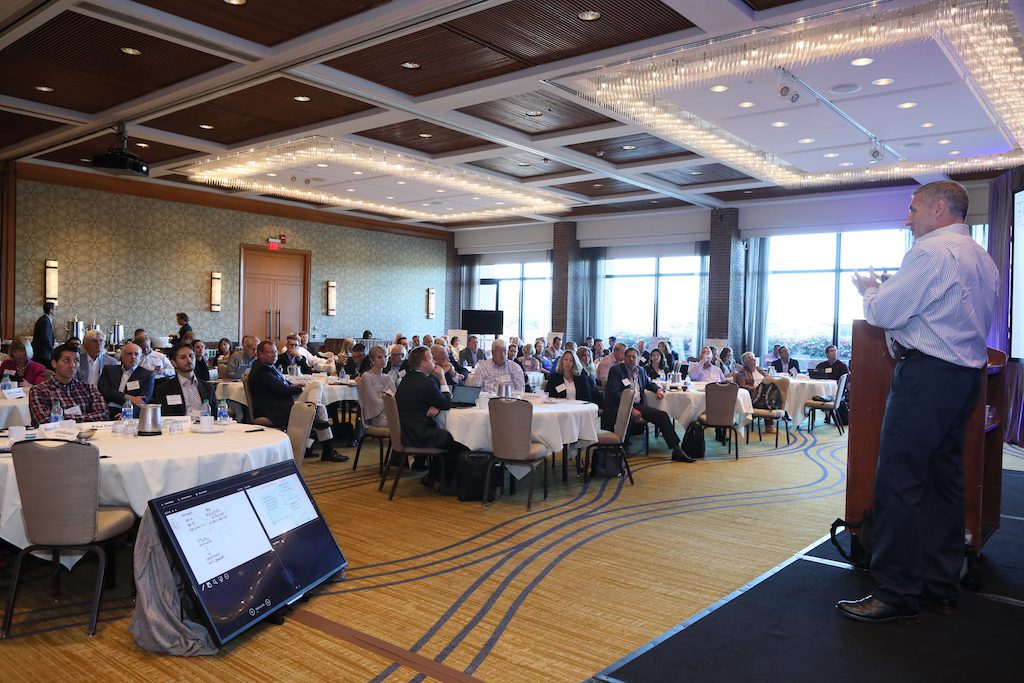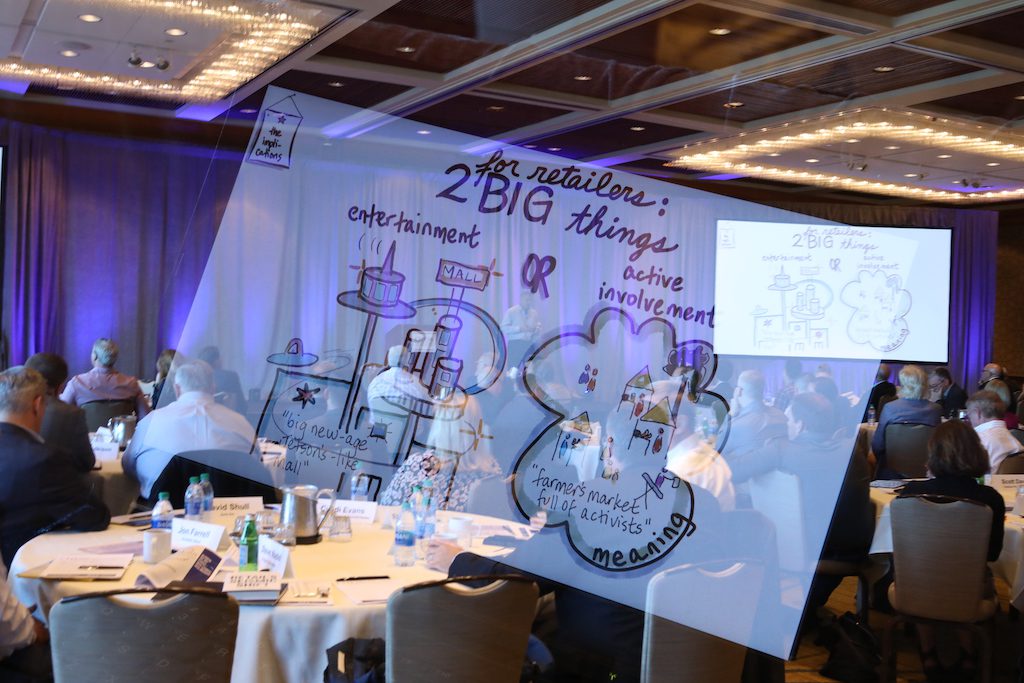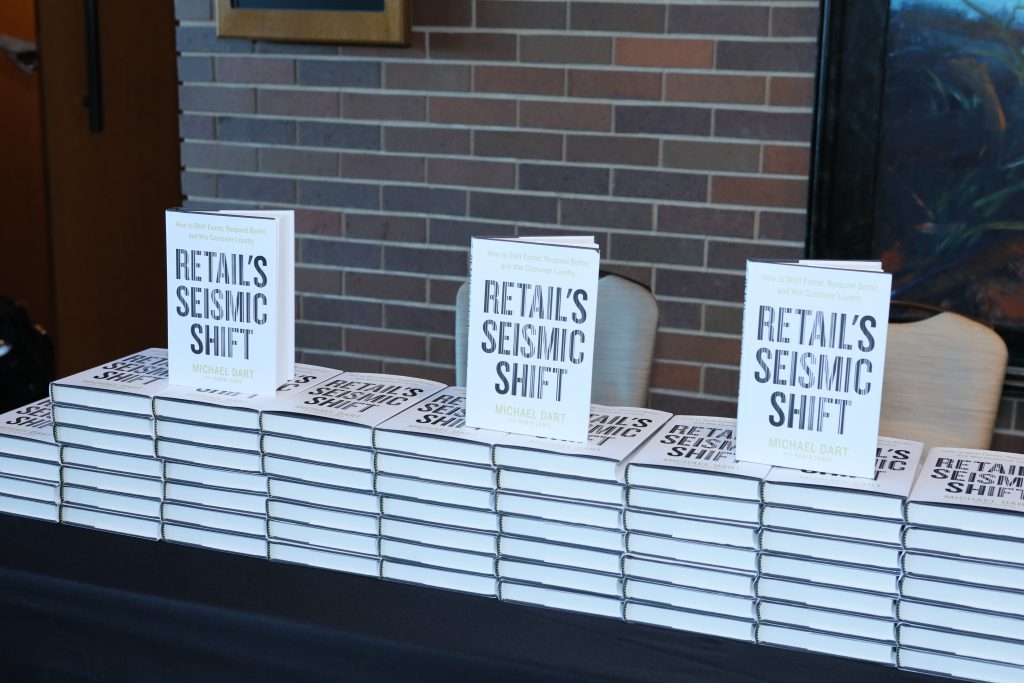Presented by: Michael Dart, Partner, Consumer/Retail Practice, A.T. Kearney
Retail specialist and visionary, Michael Dart advises retail and consumer companies on how best to navigate retail’s seismic shifts. He combines his economics and finance training from Oxford University and the Wharton School, University of Pennsylvania, with more than 25 years of experience consulting with A.T. Kearney and Bain & Co. to provide a unique and creative perspective on the future.
His presentation followed NPD’s Marshal Cohen, who also spoke on retail trends. Dart noted that he would offer the polar opposite to Cohen’s specific, tactical view of the retail landscape from 5,000 feet. Dart stated he would be looking at the space from 50,000 feet to share his hypotheses of what retail looks like in the future. We are living in a transitional age during a foundational shift in retail. After a century of infrastructure designed for the car, retail now is designed for mobile smart devices. And while economic strength appears to be robust, many are anxious about a possible recession.

End of Mass Markets
Standardized, replicable, commodified retail experiences are breaking down in the face of personalization and customization. Retailers will have to become platforms or they will lose share. There will be dramatic readjustments in real estate and capital investment. Of the roughly 1,400 malls in the U.S., 900 will disappear as the mall structure will suffer a massive shakeout.
The 21st century distribution system has changed to a subscription model as consumers increasingly value convenience. Amazon is driving this convenience, and recent research suggests that ecommerce is now about 17% of retail sales. Share shift is accelerating as digital maintains its growth rate year over year on a bigger base, outpacing brick and mortar during the last 20 years.
Dart compared Walmart’s percentage of U.S. retail sales since it went public 45 years ago and Amazon’s share, which has had a similar path for 20 years. However, Amazon is now on a steeper trajectory, partially due to the network effect and because Amazon has its infrastructure in place to build on incremental sales. Another consideration is where consumers begin their online searches. Amazon now leads Google and branded sites.
Implications of the Transformation from Mass Market
The word “store” will disappear since retailers don’t need to store things anymore. They will have to transform and reinvent themselves as high-end entertainment destinations, like Hudson Yards, or become like a farmer’s market—a site for community activities offering meaningful, vibrant connections, music and food. Retailers who don’t define themselves in these ways will struggle.
Small specialty stories, such as “mom and pop” shops, will grow. Dart noted the rise of the independent bookstore, which is one of the fastest growing retail segments. Bookshops got pounded when Barnes + Noble and Border’s faded, then battled Amazon, but have rebounded in new ways. Such stores proved that consumers value connection, community and staff that is knowledgeable about the products. Dart listed lessons learned from local bookshops:
- Curated: Selection fits my tastes and ideas
- Connected: Get e-books and local apps
- Community: You are a local person I know. You’re part of the neighborhood.
- Customization: Personal recommendations and services
Peer-to-peer commerce is coming. A site like etsy is in the early stage. Also increasing is re-commerce or selling used goods. As technology develops ways for managing payments, consumers will be able to do this without a platform in between. A platformless Amazon could be an existential threat 5 to 10 years out.
Experience/meaning is king. With the mass market breaking down, it’s critical for brands and retail to offer great experiences or have a fundamental meaning. Many brands are acting like private label with little distinctiveness with customers.

Forces Driving These Shifts
The forces driving these fundamental shifts link what’s happening in society and with retail. These spheres are inter-related and mutually supportive. Dart detailed each of the three trends, along with how they lead to new consumer values and the market implications.
These causes shift the entire basis of competition and create new business models.
- Supply/demand imbalance: Supply of products growing, demand decreasing, dematerialization, no real income growth.
- Great fragmentation: Demographics, freedom of expression, psychological status
- Technology Catalyst: Software is eating the world (application programmable interface, artificial intelligence, augmented reality, self-driving vehicles).
Experiential Retailing
Dart powered through some characteristics of experiential retailing, including Immediacy; Personalization; Interpretation; Social sharing; Embodiment; Patronage; and Discoverability. He illustrated these topics with intriguing anecdotes. For example, Japan is a leading indicator for where the U.S. is heading. The Japanese have a word that means a “shining moment” – an experience that attracts visitors who go there specifically to share the moment. A restaurant creates the perfect visual for sharing the experience on Instagram. A business intentionally uses services as the stage and products as the props to engage an individual at the emotional, physical, intellectual or even spiritual level. People dressed in costumes come to take photos of themselves posing in such environments. Adventure is dangerous but boredom is lethal. Today many retailers are boring places to shop.
Can a brand have a great meaning? Do you view consumers as the buyers of your products, or do you care about their lives? That’s rational altruism or empathetic retailing. Dart gave the example of Patagonia whose core constituency is anti-establishment, anti-consumerism and environmentally concerned. Their “Don’t Buy This Jacket” campaign told Patagonia’s devoted fans that they should not buy this jacket unless they really need its performance and would use it as intended. Patagonia has a phenomenal following and the campaign truly connected with its audience. Do you have an equivalent message to show that your product reflects your customers’ lives and interests?

Youth is the Formative Moment
What will the consumer want? Dart analyzed the psychological impact of opinions and tastes formed during adolescence and early adulthood. He compared Boomers and Gen Z by recalling the Summer of Love and its values/characteristics: environmental movement, meditation, marijuana, health food, racial and sexual equality. Most of these issues/topics from the 1970s have become mainstream.
GenZers, ages 14-18, have similar concerns.
- Embrace diversity: 75% want equal rights for transgender
- Environmentally concerned: 50% fear extreme climate change
- View technology as tools, not games
- Don’t trust you: have multiple online personalities
- Are fiscally conservative: would rather save than spend
- Values matter: 50% take brands’ social stance into consideration
- Continually connected: 94% online, every day
Such values upend the traditional view of value, which was based upon price/benefit x advertising to price/benefit + values x peer recommendations. These new consumer values also upend Maslow’s hierarchy of needs; now that the base of the pyramid is satisfied (safety, food and shelter), attention moves up to psychological needs, relationships, self-fulfillment and creative needs. Research reveals that emotionally connected consumers spend 52% more than highly satisfied but not emotionally engaged consumers.
Returning to his examples about how stores/brands vs. Amazon compare in their approaches to satisfying customer needs and aligning with their values, Dart outlined the implications. He summarized his rapid-fire examination of cultural forces shaping retail for the future by itemizing aspects of the winning model:
- Community
- Customization
- Connectivity
- Convenience
- Content
- Curation + choice
- Control

Attendees peppered Dart with questions about how to get customers to become evangelists, shipping and environmental costs, world-wide connectivity and instant viral activism about global concerns. Dart then engaged with audience members while signing his book, Retail’s Seismic Shift.
To learn more about Michael Dart’s work, see https://www.atkearney.com/michael-leonard-dart



